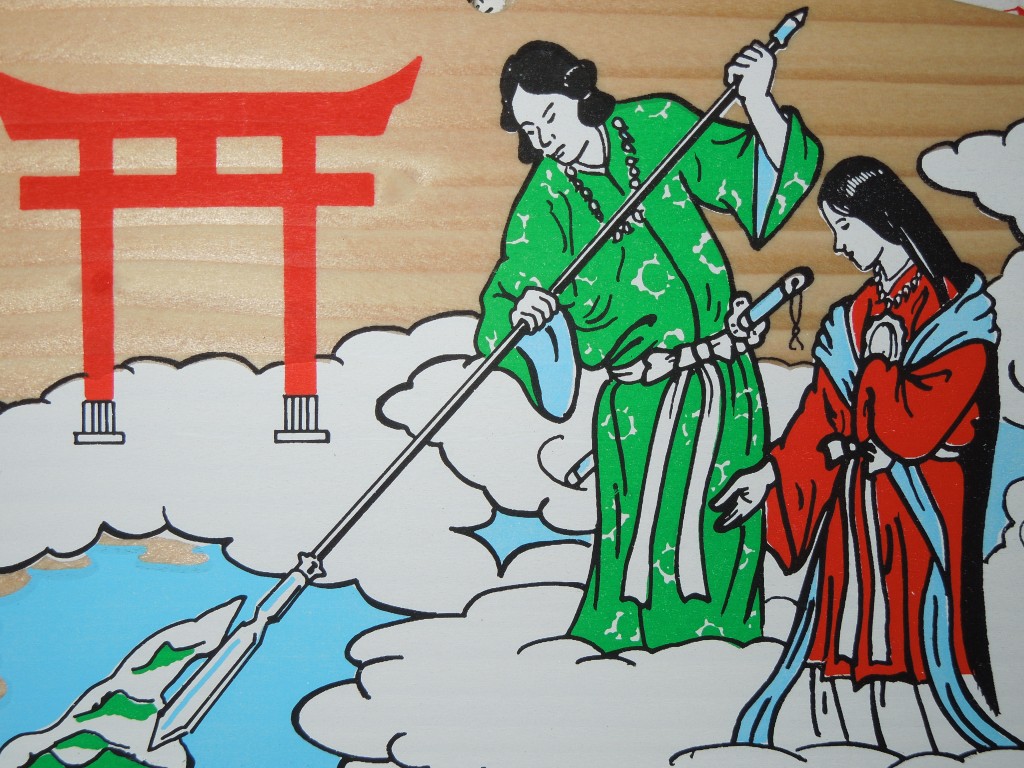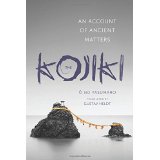
The mythological beginnings of Japan, according to Kojiki
Green Shinto reader, Quin Arbeitman, has written in about the just published new translation of Kojiki (712), Japan’s oldest writing. As he says, it’s “A much needed development, as the Basil Hall Chamberlain translation is generally considered a needlessly difficult read, and the well-regarded Philippi translation sells for hundreds of dollars due to the fact that reprints are prevented by legal squabblings over his estate.”
The new translator, Gustav Heldt, is an associate professor of Japanese literature at the University of Virginia and the author of The Pursuit of Harmony: Poetry and Power in Early Heian Japan. Green Shinto is very grateful to Quin for his first impressions of the book, which has been out for less than a week….
******************************************************

Quin in his guise as a jazz musician (courtesy fukuoka.now)
I am finding this new Heldt edition extremely readable. It goes down quite smooth and easy. Its language is simple but suitably evocative. It is in marked contrast to the Chamberlain, who in fact argued that the language of the Kojiki “…sounds queer and bald in Japanese, … and it is therefore right, even from a stylistic point of view, that they should sound bald and queer in English.” I don’t have the familiarity with Old Japanese to make this judgment for myself, but I for one am grateful that Heldt has not adopted Chamberlain’s approach to his prose!
Even leaving aside artfulness of the translation, there is one more very important reason for a new translation. One of the most frustrating aspects of the Chamberlain edition is that he, proper Victorian gentleman that he was, chose to translate anything which he considered “indecent” not into English, but Latin. This results more than a few long tracts of Latin text at important moments in the narrative, as well as several odd sentence constructions such as “…the women weaving the heavenly garments were so much alarmed that impegerunt privatas partes adversis radiis et obierunt.” (In Heldt as “Startled by the sight, Weaver Woman of Heaven slammed her weaving shuttle into her privates and died.”) And this is the only edition of the Kojiki that most bookstores have ever sold! It’s frankly rather amazing that it’s taken 132 years for a new widely available translation to appear in English.

The new translation of Kojiki has Ise's Meotoiwa rocks on the cover, said to reprsent the primal mythological couple of Izanagi and Izanami
Heldt makes the choice to translate all Japanese names etymologically by their kanji. For instance, Amaterasu (天照) appears as a character named “Heaven Shining”, and Okuninushi (大國主) as “Great Land Master”. He is even more poetic in his approach to place names, for instance giving Ise (伊勢) as “Sacred Streams”, and Izumo (出雲) as “Billowing Clouds”.
On the whole, I quite like this approach, as the sheer number of personal and place names in the Kojiki is rather dizzying even in simple English, let alone in the cumbersome cipher of romanized Japanese. Besides, tales of the Great Land Master adventuring through the land of Billowing Clouds has a certain mythic scope and poetry to it which is rather appropriate for a work such as this.
There is also a pair of maps at the back of the book, which give a useful layout of Japan in the Mythical Era. It is far more readable than the rather vague, borderless map included in the Chamberlain, and makes for fun comparisons with modern Japan.
I do have one fairly major gripe with this new edition, though. This is to do with how Heldt has chosen to deal with giving outside information. Unlike Chamberlain, who included pedantic footnotes quite literally as long as the text of the translation itself (resulting in a murder weapon-worthy 592 pages versus the Heldt edition’s 312), Heldt has chosen not to include footnotes or endnotes at all, so as to keep the text readable and flowing. I respect this, but unfortunately Heldt’s own system verges on unusable.

After more than 100 years, time for a new translation of this book too.
He includes three glossaries, one for “general terms”, one for personal names, and one for place names. The listings under “general terms” are sometimes interesting, but because there are no indications in the body of the text itself leading to the glossary, I would never think to look up words as mundane as “arrow”, “bamboo”, and “banner”– just to pick three from the first page– in order to read their enlightening entries. And as for the name and place glossaries, the worst problem is that they are listed alphabetically in order of Heldt’s own translations of them– and there is no cross-reference index by original Japanese name. Let’s say I want to look up all of the places where Ninigi shows up in the Kojiki. How the heck is anyone supposed to know that Heldt calls him “Ripening Rice Ears Lad”? There are literally hundreds of names in the Kojiki, so there’s no excuse for the lack of a cross-reference index for searching by romanized Japanese spelling, which would have taken all of perhaps four or five double columned pages.
Still. That’s only an issue if one wishes to use this text as part of fairly deep studies of Shinto. For the casual reader who just wants to read the oldest source of Japanese myth, free of “bald and queer” Victorian grandiloquence pocked with prudish Latin, this is the new go-to source. I’ll definitely be recommending it to others in the future.
Now here’s hoping for a modern translation of the Nihongi…

Nice article, Quin! I’ve been looking into the Kojiki for an article I’m writing for a Russian blogger who wants an international political perspective.
Pat, there’s another version of Kojiki which has been recently published, and I’m hoping to get a review of it from a special contributor soon…